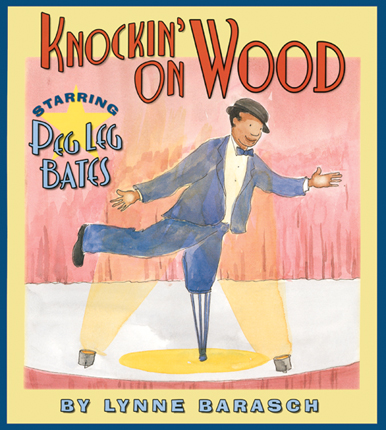Full Text Reviews: School Library Journal - 06/01/2004 Gr 1-4-This inspiring biography of Clayton "Peg Leg" Bates, who lost his left leg in a cottonseed mill accident in 1919 at the age of 12, chronicles the man's amazing life from his days as the son of a sharecropper in South Carolina to his rise to fame as a tap dancer. His special step, the American Jet Plane, in which he "tapped across the stage, leaped five feet into the air, and landed on his peg leg with the other leg straight out" won over black and white audiences alike. Still, he was never allowed to eat or sleep in the same restaurants and hotels enjoyed by white vaudeville performers. Eventually he became so famous that he appeared on The Ed Sullivan Show and in movies, performed for the king and queen of England, and opened his own resort in the Catskills. Barasch's watercolor-and-ink cartoon paintings capture the poverty of the dancer's early life, the adulation of his fans, and his joyous love of dancing. Vignettes across a spread depict him performing typical tap steps in his own unique way. A final photograph of Bates in action is complemented by his words: "Don't look at me in sympathy,/I'm glad that I'm this way./I feel good, knockin' on wood." Pair this with Kathleen Krull's Wilma Unlimited (Harcourt, 1996) for a look at some real-life heroes.-Marianne Saccardi, Norwalk Community College, CT Copyright 2004 Reed Business Information. - Copyright 2004 Publishers Weekly, Library Journal and/or School Library Journal used with permission. Bulletin for the Center... - 07/01/2004 Clayton Bates was born in South Carolina in 1907, the apple of his sharecropper mother's eye and an irrepressible tap dancer from early youth. At twelve, he took a job in the local mill as an alternative to the field work he hated, but a tragic work accident resulted in the amputation of his left leg. The determined young man refused to abandon his dancing, however, and with the help of an uncle who made him a special prosthesis suitable for tap dancing, he embarked on a remarkable, successful, and extremely long career. The streamlined text leaves some questions unanswered, and the absence of any historical or biographical notes or source citations is, unfortunately, a major stumble in an otherwise smooth routine. Aside from that, however, this is a compact and enlightening biography of an unusual figure. The easygoing text quietly provides historical context enough to understand Bates' world, simply explaining components from sharecropping to segregation to theatrical history (Bates' dancing took him from black theater to vaudeville in "blackface" to performances before royalty and on television). Barasch's line-and-watercolor art has an unforced fluidity that recalls Elisha Cooper's work; Bates is a natty and amiable figure, whose airborne exuberance conveys his love of his art form. This will provide a useful dance counterpoint to all those pink ballet books, and it's also a lively and capable tribute to an American original. - Copyright 2004 The Board of Trustees of the University of Illinois. Booklist - 06/01/2004 for reading aloud. The name Peg Leg Bates is no longer familiar, but his story is captivating. Born a sharecropper's son, African American Clayton Bates never wanted to do anything but dance, yet he had to bring in money, so at 12, he got a job at a cottonseed factory. Within three days, he had lost his leg in a machine accident. Despite that misfortune, he pursued a successful dancing career. Wearing a wooden leg, he was soon performing for black audiences; eventually he made his way to national venues such as the Ed Sullivan show. Sprightly ink-and-watercolor art ably depicts both the poverty of Bates' early life and the colorful world of entertainment. A remarkable two-page spread bridges the before and after, showing many small images of Bates in various tap dancing positions. Barasch subtly sets the story against American racism; to join a white vaudeville troupe, Bates had to wear blackface, and to eat he had to find a restaurant in the black community. Still, Bates prevailed. Quotes at the book's conclusion offer a taste of his philosophy: Black or white, one leg or two, it doesn't matter. Good is good. - Copyright 2004 Booklist. Loading...
|



